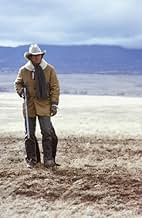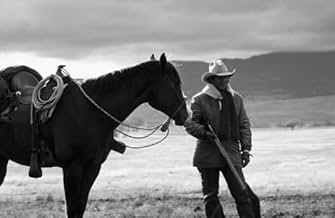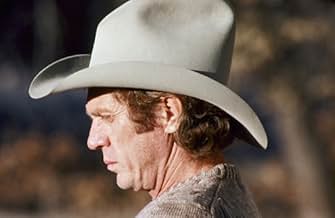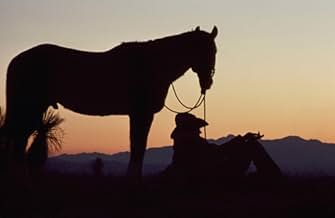An ex-army scout is hired by ranchers to kill cattle rustlers but he gets into trouble with the corrupt local officials when he's suspected of killing a boy.An ex-army scout is hired by ranchers to kill cattle rustlers but he gets into trouble with the corrupt local officials when he's suspected of killing a boy.An ex-army scout is hired by ranchers to kill cattle rustlers but he gets into trouble with the corrupt local officials when he's suspected of killing a boy.
Elisha Cook Jr.
- Stablehand
- (as Elisha Cook)
- Director
- Writers
- All cast & crew
- Production, box office & more at IMDbPro
Storyline
Did you know
- TriviaFilmed at the beginning of 1979, Steve McQueen was already very ill with cancer. He had difficulty breathing, and began coughing up blood towards the end of filming, but assumed he had pneumonia.
- GoofsIn the opening sequence, the wording says, "In 1901 he drifted into Wyoming 'Territory'". Wyoming had been a state since 1890.
- Quotes
U.S. Marshal Joe Belle: Do you know who I am?
Tom Horn: No.
U.S. Marshal Joe Belle: What you were in the Southwest, I was in the Northwest.
Tom Horn: I was mostly out of work.
- Alternate versionsUK cinema and video versions were cut by 39 secs by the BBFC to remove a horse-fall and to edit a scene of a man's head being blasted during a gunfight. The 2006 DVD release restores some cuts and is only missing 6 secs of the horse-fall.
- ConnectionsFeatured in Steve McQueen: The Essence of Cool (2005)
Featured review
The film is distinctive in four ways, the first being that Steve McQueen finally returned to the screen after having spent the 1970s elsewhere. He was a bounty hunter in the late 1950s on television, then jumped to prominence in "The Magnificent Seven" about 1960 and spent the next ten years as a dominant force on-screen. So this film was a "comeback." But McQueen came back as an artist, not as a cartoon version of his earlier self. His portrayal of Tom Horn does not use close-ups, quick draws or choreographed violence. The second thing that stands out here is the subject of the film, which is frontier justice on the high plains, a rough subject to be sure. "Tom Horn" (1980) is the first movie since "Shane" (1953) to deal realistically with the subject a part of which treatment is using the countryside itself as a character. There were a lot of movies beginning in the late 1960s with Clint Eastwood's "spaghetti westerns" which focused on the grisly righteousness of law enforcement, but it wasn't until Eastwood's "Unforgiven" (1998) that he finally made a movie that approached the quality of "Shane" and "Tom Horn," and employed some panoramic camera work. Third, the way the story is told is unfamiliar to most modern movie fans because it is so old, traditional and specific to the northern plains. The story is told, by veteran Western director Wiard, in the same way author Albert White Eagle tells stories, as a montage of contrasting fragments often out of chrnonolgical order -- "oh, by the way, I forget to tell you something, let me tack it on now" -- the juxtaposition of which fragments imply the surreal ambience of the times, an ambience which could not be effectively shown using the usual plot devices, cinematic close-ups, narrative summaries and chronological markers. For example, we see Tom in a jail cell looking at the clouds outside the little window, then we see him, with the same clouds in the sky behind him, shooting a young man (uncredited actor Sonny Skyhawk) who tries to kill the school marm as she bathes in the horse trough while talking with Tom. Is this something that really happened before he was locked up, or is it a fantasy or dream born of incarceration? It doesn't matter whether the scene is real or imagined, what matters is the jolt we receive by seeing it out of sequence. Most directors would have either shown Tom going to sleep in the cell, thus implying the scene was a dream, or would have had some narrative dialogue which indicated that Tom was remembering something that had really transpired. But Wiard, throughout the film, uses that northern technique. Another example is when we are visually escorted out of a scene in which Tom kills a rustler, with beautiful mountains in the background, into one where he is breaking a horse for the schoolmarm to eventually ride -- the same mountains are in the background, unchanged. A final thing about this movie was actor Richard Farnsworth. This was the first movie in which he had considerable dialogue, and was given a chance to demonstrate his skill at characterization. He plays John Coble, Tom Horn's employer. At the end of the movie is a 1904 quote from Coble, saying that that Tom was not guilty of the crime of which he was accused and convicted. This quotation, as Western researchers know, is from Coble's suicide note. And it foreshadowed Farnsworth's sucide twenty-two years later, a few months after being nominated, finally, for an Academy Award for his brilliant portrayal in "The Straight Story." McQueen, on-screen, and Farnsworth, on-screen and off, epitomized that quality of the Westerner least understood by people in the rest of the nation. The real Tom Horn said, "The people in the Northeast hire us to protect them from the people in the South," and, "We find the thing, whatever it is, then somebody else gets the glory for bringing it down, and somebody else makes the money for taking it back to the folks in town," but "You can either laugh or cry at your fate, and that's not much of a choice, is it, pardner?" The droll stocism and sardonic wit of the cowboy, and the western tracker whether white or Indian, has always enchanted and mystified the rest of the nation, and never really been understood. The movie, "Tom Horn," is a fitting tribute to the history and people of the northern plains, to Steve McQueen's artistry, to the memory of Richard Farnsworth, and to stories that are not easy to tell.
w. t. benda
w. t. benda
- How long is Tom Horn?Powered by Alexa
Details
Box office
- Budget
- $3,000,000 (estimated)
- Runtime1 hour 38 minutes
- Sound mix
- Aspect ratio
- 2.39 : 1
Contribute to this page
Suggest an edit or add missing content



































